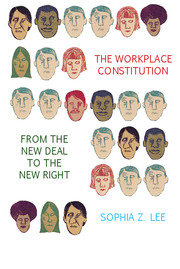Book contents
- Frontmatter
- Contents
- Acknowledgments
- Introduction
- Part I Crafting the Workplace Constitution in the New Deal 1930s and 1940s
- Part II Advancing the Workplace Constitution in the Cold War 1950s
- Part III Administering the Liberal Workplace Constitution in the Long 1960s
- 7 Agencies Recognize the Liberal Workplace Constitution in the New Frontier
- 8 The Liberal Workplace Constitution on the Air and over the Wires
- 9 The NLRB Expands the Liberal Workplace Constitution
- Part IV The Workplace Constitution in the New Right 1970s and 1980s
- Epilogue
- Appendix: Figures
- Notes
- Selected Bibliography of Primary Sources
- Index
8 - The Liberal Workplace Constitution on the Air and over the Wires
Published online by Cambridge University Press: 05 October 2014
- Frontmatter
- Contents
- Acknowledgments
- Introduction
- Part I Crafting the Workplace Constitution in the New Deal 1930s and 1940s
- Part II Advancing the Workplace Constitution in the Cold War 1950s
- Part III Administering the Liberal Workplace Constitution in the Long 1960s
- 7 Agencies Recognize the Liberal Workplace Constitution in the New Frontier
- 8 The Liberal Workplace Constitution on the Air and over the Wires
- 9 The NLRB Expands the Liberal Workplace Constitution
- Part IV The Workplace Constitution in the New Right 1970s and 1980s
- Epilogue
- Appendix: Figures
- Notes
- Selected Bibliography of Primary Sources
- Index
Summary
“A constitutional requirement to serve the community”
Howard Glickstein“The tide of black revolution has begun to beat against the television establishment,” the industry magazine Broadcasting reported in the fall of 1969. During the 1960s, militant African American activists targeted the Federal Communications Commission, a staid and powerful regulatory agency not generally associated with the civil rights movement’s nationalist turn. A new organization called Black Efforts for Soul in Television, or BEST, had recently petitioned the FCC, seeking to block a Washington, D.C., station from renewing its license to broadcast over the government-controlled airwaves. BEST’s chairman announced the challenge wearing an African-style dashiki, short Afro, and the thick-rimmed glasses signifying the black radical intelligentsia. WMAL-TV was the “supreme racist” of Washington-area stations, BEST charged: the staff was mostly white, half its black employees worked in custodial positions, and its programming “misrepresented blacks and the idea of blackness in a derogatory and insulting manner.” Television, one petitioner claimed, did not “portray blacks in a way that was meaningful either to the blacks themselves or the whites in the ‘golden ghetto’ of the suburbs.”
The liberal workplace Constitution was transformed following the National Labor Relations Board’s 1964 Hughes Tool decision. Hughes Tool and the legal theories on which it rested spread quickly among activists and government officials, eventually taking root at the FCC and facilitating BEST’s petition. Meanwhile, Title VII of the 1964 Civil Rights Act, which had prohibited employment discrimination, both spurred the workplace Constitution along and complicated its path. Regulatory agencies now struggled not merely with the relationship between their statutes and the Constitution, but also with how Title VII should affect their calculations. As officials and activists sorted out these relationships, they expanded the liberal workplace Constitution’s reach: They contended that it barred statistical underrepresentation like that at WMAL-TV. They also asserted that it was an essential component of the “public interest” that agencies like the FCC and their licensees were obligated to serve.
- Type
- Chapter
- Information
- The Workplace Constitution from the New Deal to the New Right , pp. 155 - 174Publisher: Cambridge University PressPrint publication year: 2014



